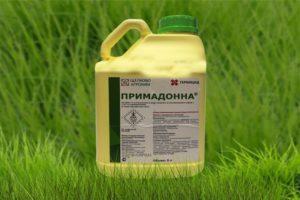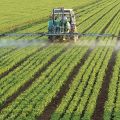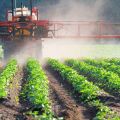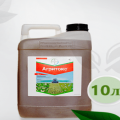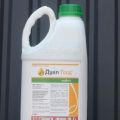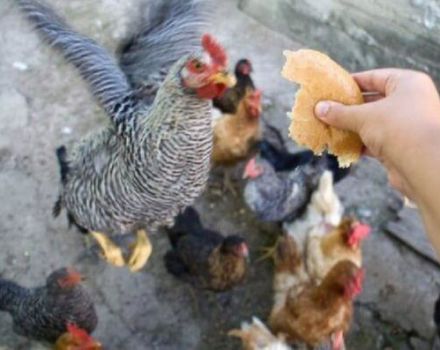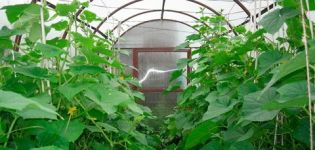Instructions for the use of herbicide of continuous action Total
Weeds are the scourge of orchards and vegetable gardens. But if we ignore the fact of their existence, one can hardly dream of a good harvest. Among gardeners, they often talk about the herbicide Total, which is increasingly attracting users. But before using the drug, it is necessary to learn more about the properties of a continuous herbicide and its use to destroy perennial and annual weeds.
Composition, properties and form of release
At the heart of the Total drug is the active substance glysophate, the second name of which is isopropylamine salt. The chemical compound in the preparation is not presented in pure form, but in the form of an aqueous solution.
If 480 g of glycophatic acid are used per liter of water, the herbicide is called Total 480. To purchase a less concentrated solution, choose Total 360.
Properties
The main properties of the herbicide:
- economy and efficiency;
- does not concentrate in the environment;
- does not bear residual soil and water impact. Splits into simple formations in 2 weeks;
- continuous action drug;
- spraying with the drug does not disturb crop rotation;
- when used correctly, it frees land plots from malicious weeds that do not lend themselves to other means;
- Total destroys hydrophytic weeds. Recommended for combating sedges, cattails and other representatives;
- the drug acts as a desiccant before harvesting.
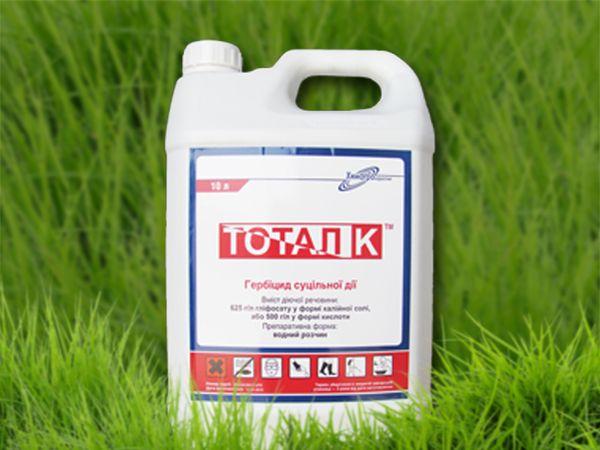
Release form
Herbicide Total is available in cans of 10 and 20 liters.
Advantages and Disadvantages of Herbicide
Among the advantages are the following points:
- minimum product consumption for spraying large areas;
- efficiency of use on erosive soil;
- good compatibility with similar drugs;
- compatibility with nitrogenous fertilizing;
- use at any air temperature;
- effective destruction of vegetation, including perennials.
Even such an effective remedy has disadvantages. The effect of the herbicide is reduced in the presence of dust on plants or high humidity. And in severe drought or severe frosts, the substance is not able to get to the roots.
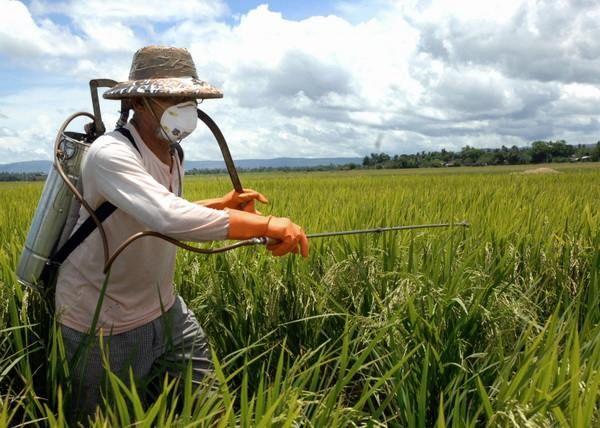
Field of activity of Total
The herbicide is used to treat agricultural land or private farms from weeds. The scope of action of the drug is the destruction of weeds that do not lend themselves to other means and mechanical stress.
On garden plots, the herbicide is used for the same purpose, but Total is not recommended for use where the plantings are less than 3 years old.
How the drug works
Total penetrates deep into the plant after falling on the foliage. It enters the stems, other organs, and gets to the roots. Thanks to glyphosate, the cellular structure of the weed is destroyed, growth points are eaten away. The plant dies off. The rest of the organs, aboveground and underground, perish.

Speed and duration of exposure
Symptoms of the phased effect of the drug:
- Foliage: yellowing, followed by browning, then wilting.
- The dying off of plant parts: stems, then roots, finally, underground shoots.
Symptoms of herbicide exposure appear on annual weeds 3-4 days after treatment. On perennials - for 7-10 days. Weed death occurs in 10-15 days. But there may be a delay of up to 30 days. It all depends on the weather and the type of weed.
Consumption rates
The calculation is carried out depending on the type of weeds that will be treated. For one-year weeds, you need 2-4 liters per hectare. For perennials, the rate is increased to 4-6 liters.
Preparation of working solution
The preparation of the solution is carried out strictly according to the instructions:
- The required dosage is calculated, depending on the area of the treated area.
- The container is half filled with water.
- The total is added with constant stirring of the solution.

How to use it correctly?
Processed according to the instructions. For the procedure, you will need a sprayer. According to the rules, spraying is performed once a season. The timing depends on the modification of the weed and the stage of its development.
- Annual weeds are processed when the first 2 leaves are formed.
- Perennial weeds are sprayed during the formation of rosettes.
- For the treatment of cereal weeds, stem growth is taken into account. The height of annual weeds should not exceed 5 cm.
- The use of a herbicide for perennial grass is reasonable with a stem height of 10-12 cm.
Important! Before preparing for spraying with Total herbicide, it is recommended to inquire about the weather forecast. If rain is expected in the next 6 hours, treatment is meaningless.
Precautions and storage
It is not recommended to carry out treatment with herbicide if the wind force is more than five meters per second. In strong winds, the chemical can get on the grown crops. To prevent this from happening, on the bushes, the lower branches are cut off, and the rest are covered with agromaterial or a casing.
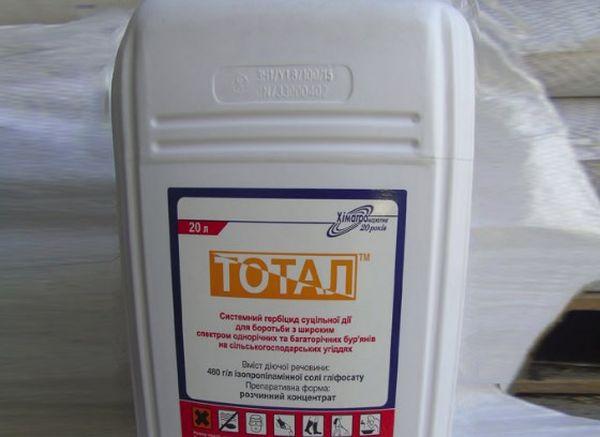
Since the drug is of the third hazard class, it is stored at 5-35 ° C in a closed container with a tight lid.
Similar means
Continuous herbicides:
- Tornado 500 VR;
- Grader, VGR;
- Napalm-480;
- Octopus Extra;
- others.
Subject to the instructions and rules for using the drug, gardeners will successfully get rid of weeds without harm to cultural specimens.
